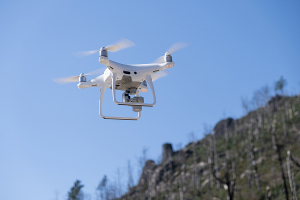Improvements needed to make drone delivery of AEDs in rural areas fast as possible
by
John R. Fischer, Senior Reporter | November 13, 2023

Refinements in drone technology are needed to reduce disparities in access to AEDs for cardiac care between urban and rural areas.
A research simulation in North Carolina has revealed potential refinements that may reduce the time it takes for drones to deliver defibrillators to patients experiencing out-of-hospital cardiac arrest in rural areas.
The rate at which AEDs are applied by a bystander is low, with timely access to an AED a major barrier, especially in rural areas, according to the American Heart Association.
Developed by researchers in North Carolina, Georgia, and Canada, the simulation model evaluated how fast an automated external defibrillator (AED) could be delivered in 19 urban and rural counties in North Carolina, with the goal being to maximize the number of out-of-hospital cardiac arrests for which an AED was delivered within five minutes.
Aiming to identify the fastest method and areas where drone delivery is most beneficial, the model operated under the assumption that all local first responders, including EMS, firefighters, and police officers have an AED on them. It then optimized a network of drones that carry AEDs and compared the response times between its hypothetical intervention and the historical response times of traditional first responders in each county.
When looking at this data, the researchers found that five-minute response times improved from 24% to 77% in urban areas and 10% to 23% in rural ones, and that estimated average response times dropped by 42% to 4 minutes and by 24% to 7.1 minutes, respectively.
But because historical response times were longer than five minutes in both, the algorithm largely ignored historical inequities in response time and primarily diverted drones to densely populated urban areas where it was easier to respond.
“For future development of drone delivery systems, we need to consider the demography, geography, and historical EMS response times of the intervention region, and personalize the algorithm that optimizes the drone locations for that region, or we risk increasing the inequity of emergency response,” said study lead author Jamal Chu, a Ph.D. student at the University of Toronto, in a statement.
Additionally, they assumed that for every AED delivered, a bystander would retrieve and use it on a patient. Instead, they realized that community education programs are needed with drone programs to ensure this.
For the study, the researchers looked at nearly 9,000 out-of-hospital cardiac arrests (more than 5,700 urban and around 3,200 rural) between January 2013 and December 2019. Only counties with 10 or more out-of-hospital cardiac arrests per year in rural and urban areas were looked at to compare resource allocation for counties with large geographic variations.
Counties with less than 25% of the population in rural areas were classified as urban, and those with 25%-75% as mixed. Ones with more than 75% of the population were considered rural.
“The biggest limitation of this study is that it is computational,” said Chu. “Going from computational analysis to implementation will include many hurdles in terms of regulations, infrastructure, and community.”
The findings will be presented at the American Heart Association’s Resuscitation Science Symposium 2023, from November 11 to 12, in Philadelphia.
|
|
|
You Must Be Logged In To Post A Comment
|
